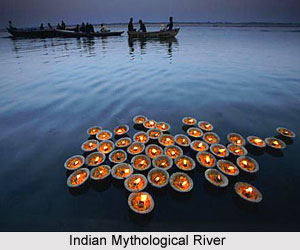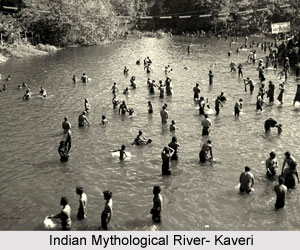During the early Vedic Ages, the Indus and the Saraswati River were considered to be the major Indian mythological rivers. But the later three Vedas gave the River Ganges much more importance as one of the holy rivers in India, shown by its numerous references. Probably the first Westerner to mention the religious significance of Ganges was Megasthenese. He has also mentioned about this river several times in his work Indika. The lines are as follows - "India, again, possesses many rivers both large and navigable, which, having their sources in the mountains which stretch along the northern frontier, traverse the level country, and not a few of these, after uniting with each other, fall into the river called the Ganges. Now this river, which at its source is 30 stadia broad, flows from north to south, and empties its waters into the ocean forming the eastern boundary of the Gangaridai, a nation which possesses a vast force of the largest-sized elephants." (Diodorus II.37.)
 In Rome`s Piazza Navona, a famous sculpture, Fontana dei Quattro Fiumi was built in 1651and is known as the fountain of the four rivers, designed by Gian Lorenzo Bernini. This fountain symbolizes four of the world`s great rivers, namely the Ganges, the Nile, the Danube, and the RÃo de la Plata, also representing the four continents known at the time. The religious texts of India have repeatedly mentioned the importance of water and rivers in different contexts. Water is quoted to be Life or "Jeevanam".
In Rome`s Piazza Navona, a famous sculpture, Fontana dei Quattro Fiumi was built in 1651and is known as the fountain of the four rivers, designed by Gian Lorenzo Bernini. This fountain symbolizes four of the world`s great rivers, namely the Ganges, the Nile, the Danube, and the RÃo de la Plata, also representing the four continents known at the time. The religious texts of India have repeatedly mentioned the importance of water and rivers in different contexts. Water is quoted to be Life or "Jeevanam".
The Veda`s mentioned water to be life and this belief is echoed in its admiration to the four religious rivers of India. River Saraswati is mentioned 14 times in Rig Veda, which is the world`s oldest scripture and the Hindu Rivers are considered of mythological importance in Hindu philosophy. As Vedic Aryans spread out more into mainland, their outlook towards everything broadened. Other rivers came into prominence like the Ganges, Jamuna, Kaveri and Narmada. The scriptures mentioned about the seven holy rivers in India. Except Brahmaputra, all other Indian rivers are considered to be women.
In the Vedic period, the rivers were considered to be deities and worshipped with sound respect. Myths and fables, religious books and epics speak a lot about rivers. However, eventually the Ganga has become the most mentioned river in possibly all-religious texts. The holy books say that Ganga is a wild and carefree river and lived with Gods. When earth was in tatters, she was sent to regenerate this land. Lord Shiva arrested her descend by tying her in his holy locks and smoothened her nature.
The epic Mahabharata says that Ganga was mother of Bhishma, the greatest warrior of those times. The religious rivers of India are personified according to their nature. The Ganga is wild and glorious, while River Saraswati is a chain of lakes and ponds. River Godavari is known as the pebbles and stones, and the River Krishna is the dark and glowing. Although river Saraswati is the mightiest of all the rivers, however it has vanished and it has left behind a series of water bodies.
India is blessed with a river network; acting as arteries to the civilization and for that they are revered, as expression of Rivers are respected, as manifestation of Gods. Natural union of rivers, particularly during floods is considered to be the marriages of rivers. It is an occasion of auspice marriages. The Floods were welcomed and thought to bring prosperity during 2,000 B. C. Mahabharata is the greatest epic and Bhagavata is the story of Lord Krishna, where there is abundance of contexts about rivers. Krishna`s child hood and his entire romance episodes flourished along river Jamuna. The first ever river purification is done by Lord Krishnan when he ward off the evil Kalindi serpent from the river.
 The rivers have been a major source of inspiration to creative minds in India from ancient times. Starting from Kalidasa to Tagore has described the beauty and mysticism of rivers in their works. Some of the greatest works of Tagore were Subarnarekha (he called the river Golden strip). Rivers are the witness to everything - wars, births and deaths. However, the artists have always seen rivers to be a symbol of beauty, love and hope. The mythological and sacred rivers are as follows.
The rivers have been a major source of inspiration to creative minds in India from ancient times. Starting from Kalidasa to Tagore has described the beauty and mysticism of rivers in their works. Some of the greatest works of Tagore were Subarnarekha (he called the river Golden strip). Rivers are the witness to everything - wars, births and deaths. However, the artists have always seen rivers to be a symbol of beauty, love and hope. The mythological and sacred rivers are as follows.
Mythological significance of Sangam :Sangam is the confluence of three holiest rivers in Hindu mythology - the Ganga, Yamuna and the legendary Saraswati. At the Sangam, the waters of the Ganges and the Yamuna can be noticeably seen to merge into one. At Allahabad, the meeting point of the rivers is believed to possess great soul cleansing power and is a major pilgrimage point.
Mythological significance of River Jamuna: This River originates from the Champasar Glacier at an altitude of 4421 m in the state of Uttarakhand, the respected Yamuna is specially mentioned in the Hindu mythology as a mythological river.
Mythological significance of River Narmada: The Narmada is one of the most sacred of the five holy rivers of India; the other four sacred rivers of India are Ganga, Yamuna, Godavari and Kaveri. It is believed that a dip in any of these five rivers washes ones sins away.
Mythological Significance of River Kaveri: The importance of Kaveri River as most scared is also sanctioned by the fact that the pilgrims perform a holy pilgrimage of a parikrama or circumambulation of the river. The Narmada Parikrama is considered to be a praiseworthy act that a pilgrim can undertake.



















